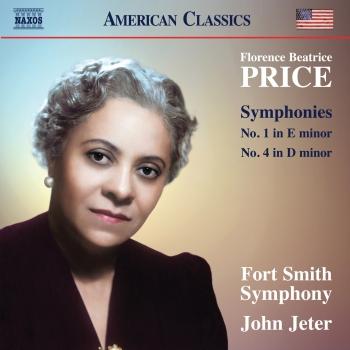
Still: Wood Notes, Symphony No. 2 in G minor 'Song of a New Race', Symphony No. 3, "The Sunday Symphony" Fort Smith Symphony & John Jeter
Album Info
Album Veröffentlichung:
2012
HRA-Veröffentlichung:
06.07.2012
Label: Naxos
Genre: Classical
Subgenre: Orchestral
Interpret: Fort Smith Symphony & John Jeter
Komponist: William Grant Still
Das Album enthält Albumcover
- William Grant Still (1895 - 1978): Wood Notes:
- 1 Still: I. Singing River Moderately slow 06:46
- 2 Still: II. Autumn Night: Lightly 02:49
- 3 Still: III. Moon Dusk: Slowly and expressively 04:27
- 4 Still: IV. Whippoorwill's Shoes: Humorously 02:30
- Symphony No. 2 in G minor 'Song of a New Race':
- 5 Still: I. Slowly 08:56
- 6 Still: II. Slowly and deeply expressive 07:14
- 7 Still: III. Moderately fast 03:37
- 8 Still: IV. Moderately slow 07:13
- Symphony No. 3, "The Sunday Symphony":
- 9 Still: I. The Awakening: Moderately fast 03:48
- 10 Still: II. Prayer: Very Slowly 06:34
- 11 Still: III. Relaxation: Gaily 02:30
- 12 Still: IV. Day's End and a New Beginning: Resolutely 05:09
Info zu Still: Wood Notes, Symphony No. 2 in G minor 'Song of a New Race', Symphony No. 3, "The Sunday Symphony"
World Première Recording! The life and career of the African-American composer William Grant Still qualifies as the quintessential American ‘success story.’ Often referred to as the ‘dean of African-American composers,’ Still rose from humble beginnings to work as an arranger while studying composition with Chadwick and Varèse. Still embraced the blues, spirituals, jazz, and other ethnic American music within classical forms. Wood Notes musically depicts Still’s love of nature. Symphony No. 2, the last of a trilogy of works depicting the African-American experience, presents the vision of an integrated American society, while Symphony No. 3 describes a spiritual ‘day in the life’ of a devout worshipper.
With this recording, Naxos and the present performers conclude their three-album series of William Grant Still’s symphonies, plus other orchestral works. I reviewed the second volume (Symphonies 4 and 5, and the Poem for Orchestra— Naxos 8.559603) for another publication, and was quite beguiled. I feel the same way this time around. This music is impossible not to like, and conductor John Jeter and his orchestra from Arkansas, the state in which the young composer spent part of his childhood, are effective advocates.
Wood Notes, a work from 1947 that is receiving its first recording here, is a suite of four movements: “Singing River,” “Autumn Night,” “Moon Dusk,” and “Whippoorwill’s Shoes.” The titles suggest that the music will be picturesque, and, in the best sense of the word, simple, and indeed it is. If there is such a thing as an American Pastoral school of composers, Still would be its dean. The Currier and Ives prints that have adorned the booklet covers in this series have been very appropriate, as they project an innocence that is also one of the strongest characteristics of Still’s music. Imagine Delius at his least Impressionistic, Dvořák at his least academic, and Jerome Kern at his most classical, and that might give you an idea of what Still’s music sounds like. (Nevertheless, Varèse was one of his teachers!)
The Second Symphony, premiered with great success by Stokowski and the Philadelphia Orchestra in 1937, is “a vision of an integrated society.” In terms of form, this is a bit more ambitious than Wood Notes , but Still’s writing is so unpretentious, tuneful, and relaxed that one can’t help asking what makes this work more symphonic than the other. The mood is sometimes wistful and often hopeful, and Still, when he is not embracing the listener outright, is at least holding his hand, or throwing his arm around his shoulder. Not surprisingly, African-American elements, both traditional and more popular (jazzy), are prominent in this work.
The “Sunday Symphony” dates from 1958. Again, naming its movements will give the reader an idea of what the music sounds like: “Awakening,” “Prayer,” “Relaxation,” and “Day’s End and a New Beginning.” Only 18 minutes long, this symphony is as suitelike as its predecessor, every bit as ingratiating, and even more uncomplicated. Appropriately, “Prayer” is the longest movement, and it builds to a soulful climax. “Awakening” and “Relaxation” both chatter away companionably, and the last movement brings the symphony to its resolute and affirmative conclusion.
I don’t get the feeling that this music makes exorbitant demands on an orchestra. The Fort Smith Symphony, a lean-sounding ensemble in the manner of Howard Hanson’s Eastman-Rochester group, puts Still’s music across capably and with sympathy. (I would have liked to have heard Stokowski and the Philadelphians play the Second Symphony, though!)
It is tempting to call this music naive, but I think to do so would say more about our lack of innocence as listeners, than about any lack of sophistication on the part of William Grant Still. (Raymond Tuttle, Fan Fare)
Fort Smith Symphony
John Jeter, conductor
William Grant Still, composer
Dieses Album enthält kein Booklet










